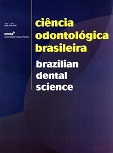Bruxismo do sono e sua associação com distúrbios do sono em policiais
DOI:
https://doi.org/10.14295/bds.2009.v12i1.250Abstract
O bruxismo do sono é uma das atividades parafuncionais mais abordados na Odontologia, especialmente devido a questões controversas quanto à sua prevalência e etiologia. Os estudos realizados na área conseguem, tão somente, amenizar seu potencial destrutivo, mas não estabelecem, todavia, uma relação direta entre causa e efeito. A literatura considera atualmente o estresse, a fisiologia do sono, algumas drogas e, em menor escala, a oclusão, como fatores desencadeadores deste comportamento parafuncional. O objetivo deste trabalho foi investigar a relação entre bruxismo do sono e distúrbios do sono, em policiais militares da cidade de São Luís-MA. Os resultados revelaram que não houve associação significante entre bruxismo do sono e distúrbios do sono (p=0,07). Conclui-se, portanto que apesar de o bruxismo ocorrer durante o sono, ele não interfere na qualidade do mesmo
Downloads
Downloads
Published
How to Cite
Issue
Section
License
Brazilian Dental Science uses the Creative Commons (CC-BY 4.0) license, thus preserving the integrity of articles in an open access environment. The journal allows the author to retain publishing rights without restrictions.
=================




























